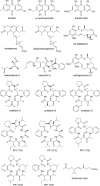Species-level assessment of secondary metabolite diversity among Hamigera species and a taxonomic note on the genus
- PMID: 25379334
- PMCID: PMC4205921
- DOI: 10.1080/21501203.2014.917736
Species-level assessment of secondary metabolite diversity among Hamigera species and a taxonomic note on the genus
Abstract
Secondary metabolite phenotypes in nine species of the Hamigera clade were analysed to assess their correlations to a multi-gene species-level phylogeny. High-pressure-liquid-chromatography-based chemical analysis revealed three distinctive patterns of secondary metabolite production: (1) the nine species could be divided into two groups on the basis of production of the sesquiterpene tricinonoic acid; (2) the tricinonoic acid-producing group produced two cyclic peptides avellanins A and B; (3) the tricinonoic acid-non-producing group could be further divided into two groups according to the production of avellanins A and B. The chemical phenotype was consistent with the phylogeny of the species, although metabolite patterns were not diagnostic at the species level. In addition, the taxonomy of the Hamigera clade was updated with the new combination Hamigera ingelheimensis proposed for Merimbla ingelheimensis, so that all species in the clade are now in the same genus.
Keywords: Aspergillaceae; Eurotiomycetes; Hamigera ingelheimensis; chemotaxonomy; diversity; phylogeny; secondary metabolite.
Figures






References
-
- Breinholt J, Kjœr A, Olsen CE, Rassing BR, Rosendahl CN Hamigerone and dihydrohamigerone: two acetate-derived, antifungal metabolites from Hamigera avellanea . Acta Chem Scand. 1997;51:1241–1244. doi: 10.3891/acta.chem.scand.51-1241. - DOI
-
- Cehulová S, Kryštofová S, Betina V, Varečka L Vanadate inhibits the production and/or release of secondary metabolites without impairing growth in several fungal species. Folia Microbiol. 1996;41:494–498. doi: 10.1007/BF02814665. - DOI
LinkOut - more resources
Full Text Sources
Other Literature Sources
